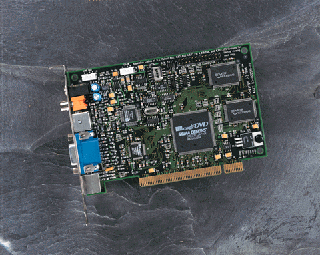
QuickTime, which launched in 1991 and therefore predates Video for Windows by about a year, introduced a fairly general framework for containers and codecs, and an initial video codec which was a fairly simple thing. I'm going to stick my neck out and argue, chronologically:

A software abstraction layer for video decoding such as DirectShow (1998).To make fullscreen full motion video mainstream, the following technologies were needed: Buffered PCM audio such as a Creative Labs SoundBlaster sound card (1989).A redistributable high capacity storage medium (such as CD-ROMs (Yellow Book), 1988) or a high speed network (such as satellite Internet, mid-'90s) to get the video data into the PC.
 15-bit color or better (late-'80s), to avoid palette issues. On PCs, this is achieved either by placing the chip on the video card (such as the ATI Rage 3D, 1996), or as described by by connecting through a VGA card's high speed feature connector to access video memory directly (such as the Sigma Designs Reelmagic CD lite, 1993), or by switching from ISA to VLB (1992) or PCI (1993). A high speed path between the video decoder chip and the video memory or video output. Or a sufficiently fast CPU such as the Intel Pentium (1993) and a high resolution multimedia timer (I think the necessary circuitry was first incorporated in sound cards before moving to motherboard chipsets). Real-time motion video decoder chips such as the C-Cube CL4000 (1993), because efficient codecs are processor-intensive. An efficient motion video codec (such as MPEG-1, 1993) to make storage or transmission of digital video practical. My question is, can it be pin-pointed the specific hardware/software technologies and when they went mainstream on new PC's to support this level of multimedia video? Naturally, this whole endeavor revolves around hardware bandwidth and codec's, which includes software components. I remember CD-ROM games such as "The 7th Guest" becoming popular based on these sorts of abilities, though that particular game falls short of the quality mark described above.
15-bit color or better (late-'80s), to avoid palette issues. On PCs, this is achieved either by placing the chip on the video card (such as the ATI Rage 3D, 1996), or as described by by connecting through a VGA card's high speed feature connector to access video memory directly (such as the Sigma Designs Reelmagic CD lite, 1993), or by switching from ISA to VLB (1992) or PCI (1993). A high speed path between the video decoder chip and the video memory or video output. Or a sufficiently fast CPU such as the Intel Pentium (1993) and a high resolution multimedia timer (I think the necessary circuitry was first incorporated in sound cards before moving to motherboard chipsets). Real-time motion video decoder chips such as the C-Cube CL4000 (1993), because efficient codecs are processor-intensive. An efficient motion video codec (such as MPEG-1, 1993) to make storage or transmission of digital video practical. My question is, can it be pin-pointed the specific hardware/software technologies and when they went mainstream on new PC's to support this level of multimedia video? Naturally, this whole endeavor revolves around hardware bandwidth and codec's, which includes software components. I remember CD-ROM games such as "The 7th Guest" becoming popular based on these sorts of abilities, though that particular game falls short of the quality mark described above. 
I believe that such capability became commonplace on new PC hardware around the middle of the 1990s. In contrast, the often-plugged aspiration was to have basically long-playing digital video on the PC at roughly the quality of a VCR / Standard-Definition Television, utilizing the full screen area, around 30 fps, and including realistic sound. Many will remember early digital videos being played in tiny windows on Windows PCs. In the early 1990s, the new buzzword for PCs was "Multimedia", and the gold standard for multimedia performance usually talked about was "full-screen full-motion" video playback.







 0 kommentar(er)
0 kommentar(er)
